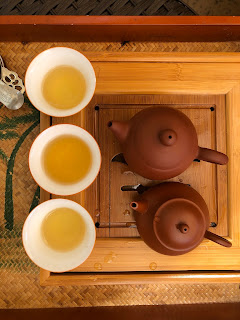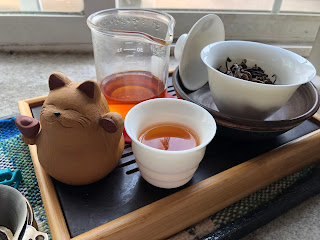Taste Testing Yixing Pots
Clay teapots are usually dedicated to a single type of tea (e.g roasted Wuyi oolongs, fruity TGY, Taiwanese gaoshans etc). However, trying to figure out what tea is sometimes tricky.
I learned this particular trick in one of my tea groups and have used it with success. I love it because it appears to my inner scientist and helps me determine if a teapot works with a particular tea. FOR SCIENCE!
The biggest benefits to these experiences are that you can "test" a pot before dedicating it to a given tea. Or you can compare two separate pots to see which performs better.
For me, when doing these tests, some of the questions I want answered are about flavor of the tea in the Yixing pots.
- Does the Yixing teapot give a better flavor than a neutral ceramic gaiwan? Y/N
- How does Yixing teapot #1 compare with Yixing teapot #2 with Tea A?
- Which tea (Tea A or Tea B) taste better in this Yixing teapot?
I hope it will provide you some guidance as to how to use your Yixing teapot.
Tea Tasting Experiment
The following is a 2-part experiment: tasting the water from the Yixing teapot and tasting tea from the Yixing teapot. You can skip Test 1 and go directly to Test 2, if you want.
What You Need:
- Ceramic teacups, which are about the same size.
- One will be your control cup, which will tells you how your neutral tea should taste.
- Other cups will be for your Yixing teapot(s).
- A fairness cup (gong da bei / chai hai)
- A large ceramic teapot or gaiwan. You need to brew enough tea that can be divided between your different cups & teapot(s)
- A tea that you can brew fairly well.
- A Yixing teapot that you want to taste test. (Up to 2 Yixing teapots)
- Before starting, decide what question you want answered about doing these experiments. This keeps you honest and not bogged down in details. (See the example experiment below.)
You can certainly do a test with more than 2 Yixing teapots but you might not be able to discern subtle flavors between different teawares. You can experiment with two pots, compare them, then take the best pot and compare with a different one.....rinse & repeat these experiments until you're happy with the taste.
Test 1: Water Tasting
Purpose: See how the Yixing teapot changes the taste of your water as compared to a neutral teaware.
- Boil hot water in your kettle.
- Warm up all your teaware.
- Pour water into your neutral gaiwan/teapot. The pour a bit into your control teacup
- Pour water into your Yixing teapots. Pour water into the corresponding teacup
- Taste your water from your control teacup. What does it taste like?
- Taste the water from the Yixing teapot(s). What does that taste like?
The water might taste different between your neutral gaiwan and your teapots. Does it taste sweeter? Crisper? Smoother? These are the qualities that will be imparted into your tea.
These flavors will all be subjective to your personal tastes. I suggest writing these results down. At this point, you might know what tea you want to try based on the flavors you're tasting just from the water. But if you still don't know, it's okay.
Test 2: Tea Tasting
Purpose: See how a tea tastes in a Yixing pot as compared to a neutral teaware.
- Warm up all your teaware! (To ensure that the teapots don't steal heat from your tea)
- Brew the tea in a neutral ceramic gaiwan/teapot.
- Pour the tea into a fairness cup.
- Divide the tea into:
- A porcelain tea cup. This is your neutral control
- The teapots you want to test.
- Pour tea from teapots into porcelain teacups.
- Taste your neutral control
- Taste the tea from the teapot(s).
- Compare the taste between your control and teapots.
You can repeat this type of experiment with different teapots or even different teas. Again, I suggest writing these notes down, especially if you're going to experiment with multiple teapots or teas so that you have a record of these results
Example Experiment
Here's an example of a tasting experiment I did. I had two pots I wanted to compare to each other:
- An existing 100 Zhuni Dragon Egg teapot (thick-wall, thrown on a wheel by a Guangdong potter) that I've already dedicated to using dan cong oolongs.
- A brand new 100 Zhuni Guava pot (thin wall, fully hand-made in Yixing style)
I'm using a Ya shi dancong oolong --- a tea that I have made before in the Dragon Egg teapot and a ceramic gaiwan with great success, which is why I chose it.
What I want to know: Will the tea taste better in the Zhuni Guava versus Dragon Egg or the Gaiwan?
I brewed the tea in a 175ml porcelain gaiwan, poured into a fairness cup, then divided it up between the neutral cup & teapots. This photo shows the tea already in cups (each cup is ~45ml).
- Top cup = The "control" poured from the fairness cup directly into the 45ml cup
- Middle cup = Dragon egg Zhuni teapot, poured directly into the 45 ml cup
- Bottom cup = Guava Zhuni teapot, poured directly into the 45 ml cup
- The control is a good cup of tea.
- I found that the tea from the clay teapots tasted better than the control from the Gaiwan. The tea is less astringent, sweeter, and more buttery.
Answer #1: Yes, the Guava teapot produced a better tea than the Gaiwan.
Interestingly, the color of the tea was different between the two teapots, which I did not expect.
- The Dragon egg tea is DARKER than the control.
- The Guava tea is LIGHTER than the control.
But was the Guava teapot better than the Dragon Egg? After 3 steeps, I found that the taste difference between the two was somewhat minor. For me, the Guava teapot produced a slightly less astringent tea that was slightly more smoother. BUT, the flavor from the Dragon Egg was more buttery, creamier, and sweeter.
Answer #2: The Dragon Egg teapot was slightly better than the Guava teapot.
BUT, the difference is so small and personal, that someone else might find the opposite to be true
Both will be good for dancong oolongs; it will depend on what I want flavors I want the tea to present.
This makes sense because Zhuni clay is said to be good for lighter teas with lots of fragrance. I suspect that the Dragon Egg with its thicker walls kept the heat in a tad longer. Or it could be that the shape of the Dragon Egg is better suited for this particular dancong tea.
There's so much to learn about different clay compositions & properties; each one interacts with tea differently. Certainly, there are guidelines, but they are JUST guidelines.
Personal taste really comes into play when it comes to various flavor notes; hence why I decided to document these experiments in taste testing. I hope these tests will help you figure out how to pair your pots with a tea.
If you have any questions, feel free to ask, and I'll try to answer as soon as I can.




Comments
Post a Comment